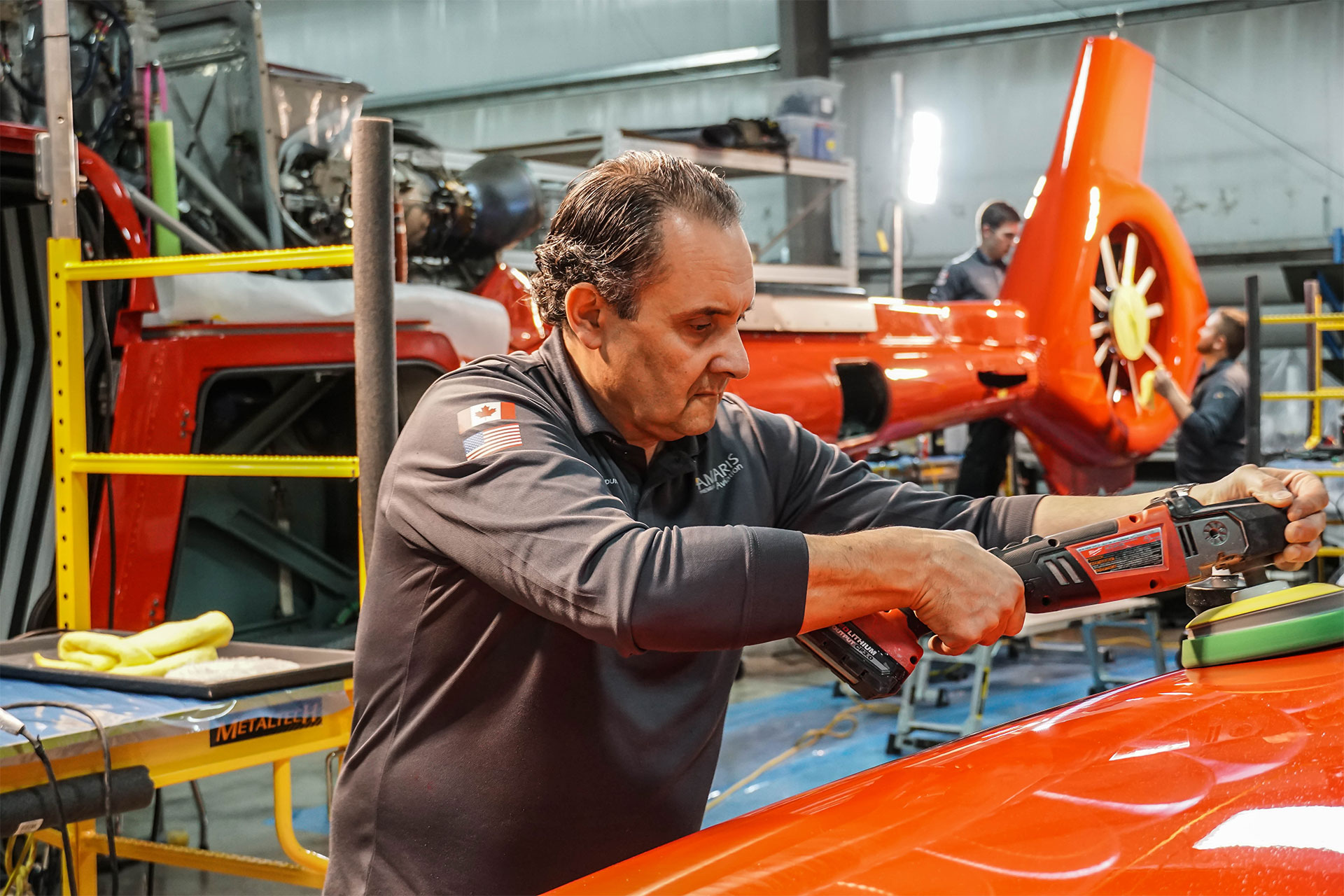Estimated reading time 12 minutes, 6 seconds.
Those who are lucky enough to own or operate an aircraft — whether it be a turboprop, business jet, or helicopter — know that along with regular scheduled maintenance, it’s also important to maintain the exterior of the aircraft. What these owners may not know, however, is they can refresh the look of their aircraft while also helping it to perform better, defy the elements, and make operations safer, too.
Family-owned business Amaris Premium Aviation specializes in maximizing aircraft functional surfaces with nano ceramic technology to improve longevity, performance, safety, and appearance — and has been doing so for the past three years. Located roughly one hour southwest of Toronto, Ontario, at Chartright Air Group’s Region of Waterloo International Airport facility, Amaris is a small business with ample hangar space — 55,000 square feet, in fact.
The start-up company led by co-founders Edrick and Joshua Dunand has developed a unique nano ceramic coating technology for the aviation industry — known as Functional-Ceramic-Nanotechnology — that provides a lengthy list of operational benefits beyond aesthetics.
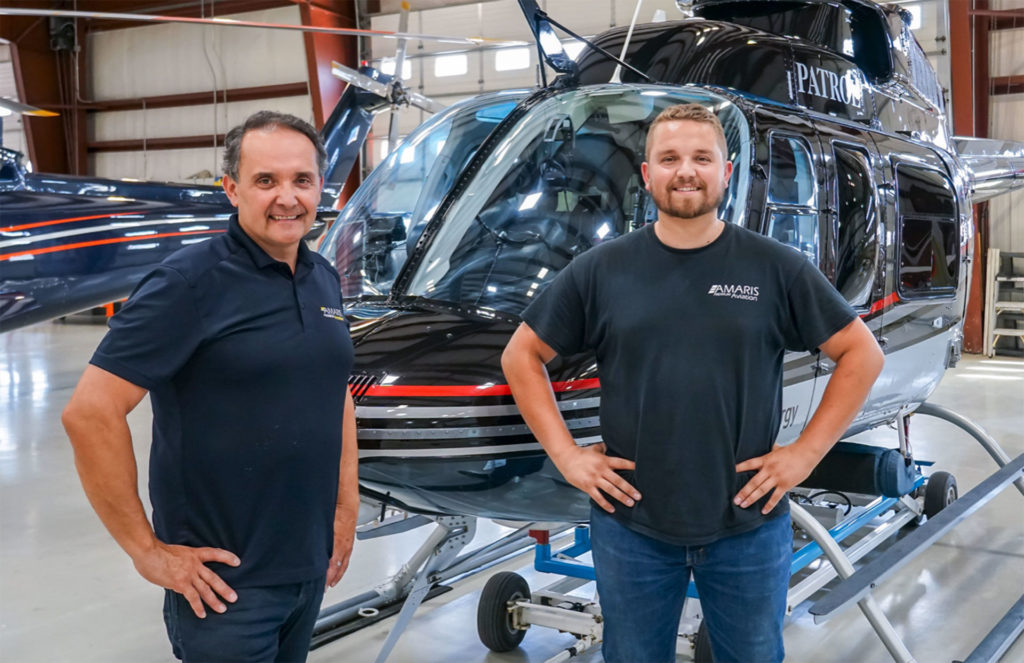
Traditionally, ceramic coating has been used for car detailing purposes. “We quickly validated, with resounding success, the use of such coatings in aviation — as a derivative of my son’s work with luxury car dealerships,” said Edrick Dunand, Amaris CEO. “We came to realize that we had to develop far more advanced solutions for aviation to provide what is now an aerospace disruptive technology.”
Dunand, who has worked extensively in the charter and business aviation industry, noted that, in the car world, the objective of detailing is “to make something pretty, to make it glossy.” But when it comes to the complexity of turbine aircraft operations — be it helicopter or fixed-wing — “detailing is only going to take you so far, and is never permanent,” he said. “So, we approached things from an engineering standpoint to design an innovative ceramic process focused on the struggles that aircraft operators are dealing with.
“Everything for us is focused on creating a return on investment, so we used an engineering approach to create new, permanent aircraft ‘super-surfaces’ at nano scale that do not interfere with the aircraft certification.”
Engineering Over Aesthetics
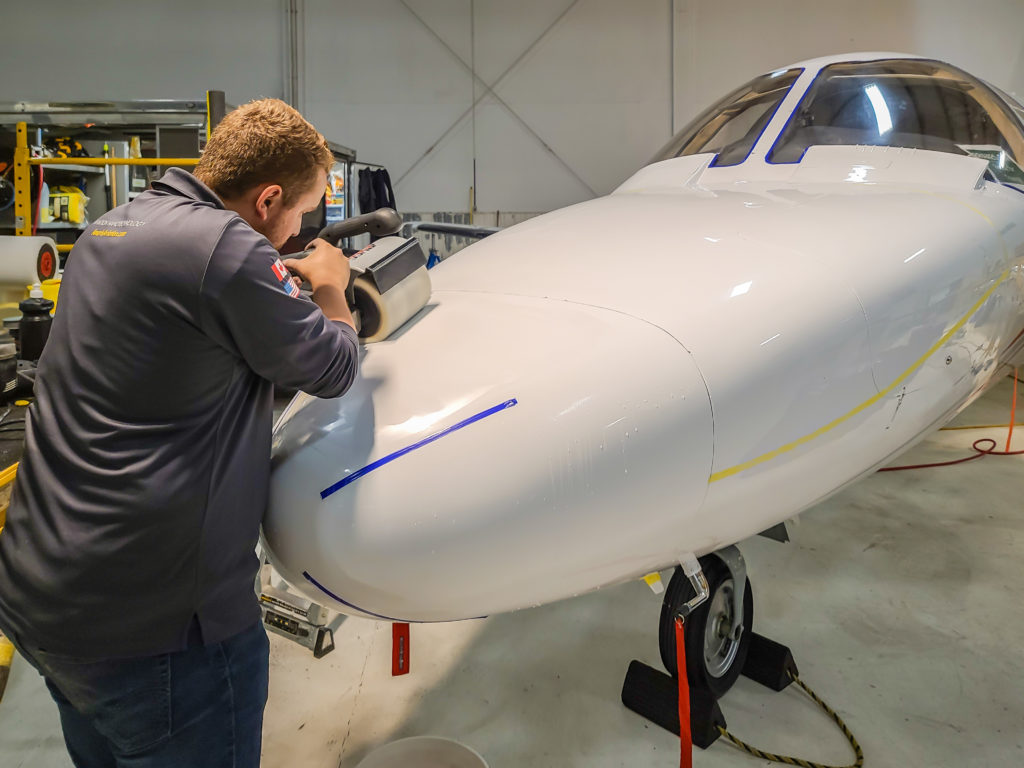
Amaris has crafted its aviation nano ceramic coating technology to impact four key areas: flight safety maximization; flight performance maximization; ease and speed of cleaning maintenance; and surface protection and longevity.
How exactly does Amaris achieve these four pillars? The company’s nanotechnology is not your average polish or sealant. Amaris equips aircraft with a molecularly-bonded functional surface, which provides extensive benefits for painted surfaces, transparent/window surfaces, and metal components. Ultimately, there is something for everyone. The company offers multiple ceramic grades to meet particular operational profile requirements, as well as a variety of custom nano ceramic packages.
It should be noted that, prior to installing the nano surfaces, Amaris completes a multi-stage polishing process, which Dunand said is “essential for perfect bonding.”
A few of Amaris’s specialties are its jeweling and optical correction processes, which are applied to create a Transparency Functional Ceramic, and can provide numerous benefits from a safety perspective, including improved visibility for pilots. With the Transparency Functional Ceramic, “a pilot has a point of view that is ‘non-swirl’ and non-disrupted; they can fly toward the sun with perfect optical clarity, with a swirl- and scratch-free windshield,” said Dunand. “Blinding swirls can be a nightmare for helicopter pilots for whom spatial orientation is everything.”
He added: “When you have a sudden encounter with water or drizzle, that is blinding and can be disorientating, and could have a negative impact on flight safety.” Dunand said after receiving the Transparency Functional Ceramic, pilots have likened their view to a high-definition TV screen that breaks rain drops; this ultimately protects forward visibility, even in the worst downpours, whether at speed or during the taxi.

This particular nanotechnology creates a water-repellent aircraft surface which makes the cleaning process much easier, too; in the long run, the latter helps to preserve the aircraft’s exterior. A jet, for example, becomes nearly “self-cleaning” while flying because “it’s so slick,” said Dunand. “This is a tremendous operational advantage.”
He added, “From a cleaning and protection standpoint, our [nanotechnology] really reduces your cost of ownership.”
To protect aircraft from the elements, Amaris engineered a Functional Ceramic Sheltering treatment. “It’s harder than a clear coat,” explained Dunand. It provides aircraft with extreme heat protection (over 1,400 F/760 C); UV protection (upward of 90 percent); and a shield from contaminants such as turbine exhaust soot, acid raid, hydrocarbons, bugs, and deicing fluids and salts. The ceramic layering can even protect paintwork from physical impact.
Dunand stressed that such protection is critical to preserve the aircraft and shelter it from exterior/paint degradation, as well as corrosion — the arch-enemy of aviation.
To further protect aircraft, namely the brightwork of flight surfaces and engine nacelles, Amaris offers permanent brightwork treatments for jet aircraft. Essentially, all leading edges and engine brightworks are finished with a jeweling aero enhancement procedure, followed by a functional nano protection treatment. This is designed to last several years and thousands of flight hours to prevent swirling or contamination.
Aside from its nanotechnology capabilities, Amaris can also rescue or restore aircraft with scratched windshield surfaces or fatigued paintwork caused by contaminants. While replacing a windshield or repainting an aircraft might be go-to solutions for some owner/operators, these are costly fixes. Amaris offers a Surface Refinement treatment that can remove over 90 percent of exterior damage. The icing on the cake is that the aircraft is returned with a high-gloss finish, as if it were freshly painted.
Surface Refinement is available for all aircraft, but is especially key for helicopter tail booms that are easily “contaminated from exhaust heat and soot, and scratched from normal cleaning — creating a rapid downward spiral even on a new machine,” said Dunand.
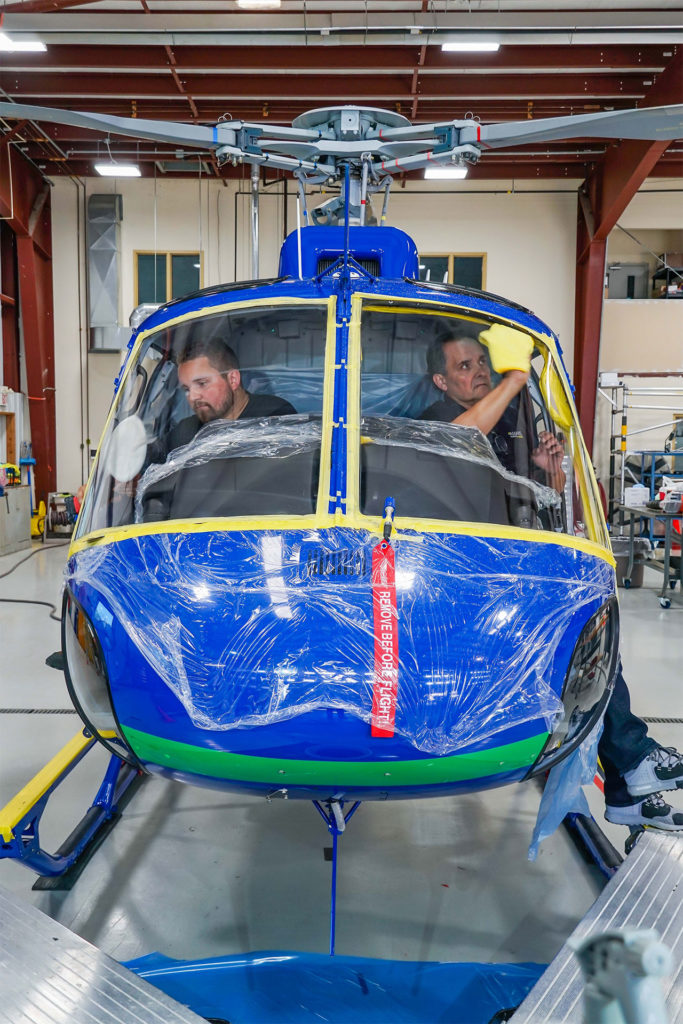
Finally, from a functionality perspective, Amaris’s Functional Surface Development helps to maximize aircraft performance in a unique way. The company specializes in equipping aircraft with a functional ceramic layering that is designed to enhance laminar airflow — ultimately improving aerodynamics, fuel burn, and overall performance efficiency.
Well Rounded

Although fully organized as a mobile operational unit, Amaris can host all types of aircraft at its Waterloo Airport facility, ranging from an Airbus H125 to a Bombardier Global 7000 or Boeing 737. The company’s airport location also makes it easy for operators to fly their aircraft directly to Amaris’s facility.
Since its inception, Amaris has completed work on upwards of 60 aircraft, comprised of biz jets, helicopters, turboprops, and even some piston aircraft. The company strives for a quick average turnaround time of one week for its nanotechnology services, but this varies based on the condition of the aircraft, size, and the operator’s needs. A larger business jet, like a Global Express, could take anywhere from two weeks to 20 days to get out the door, depending on its initial condition.
Dunand said Amaris’s “launch pad” was with private/VIP customers, but as the company gains traction, it is starting to service more large-scale fleets. Recently, Amaris welcomed a new, high-profile customer with a large fleet of Bell 429s: the Canadian Coast Guard. Under a supplemental type certificate (0-LHS19-195), Amaris runs the retrofitting of windshield transparencies on the Coast Guard’s 429s, with a combination of surface finishing and Functional Ceramic Layering services — which drastically improve pilot visibility and help to repel water from windshield surfaces.
“The Canadian Coast Guard, with their Bell 429s, fly all around Canada and in nighttime environments,” said Dunand. “When you hear these veteran pilots coming out of a storm, chased by a warm front in B.C., drenched coming out of their helicopter… and the first thing they say is, ‘Edrick, this is life changing. Situations like today are so dangerous, and because of [Amaris’s] transparency we could see right through the rain throughout.’
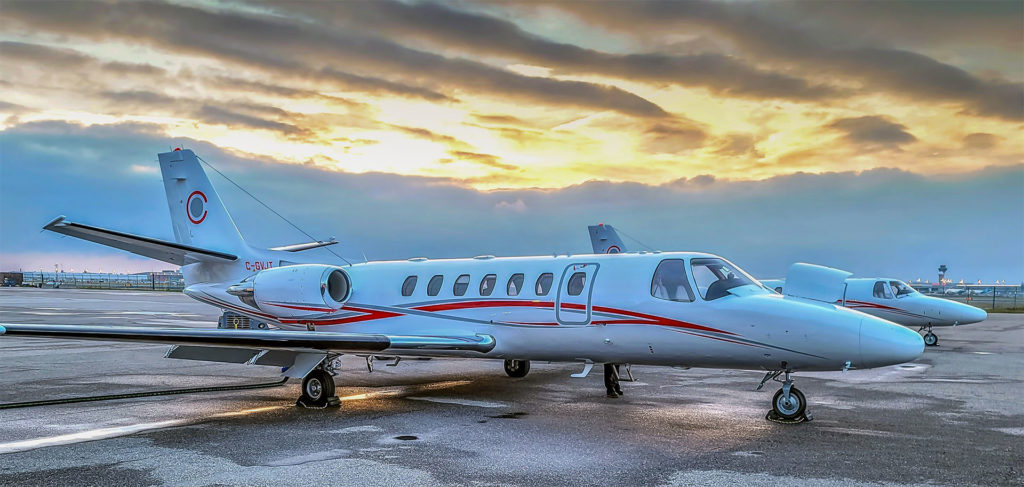
“They said their stress level goes down and focus goes up; they’re not as fatigued; their machines are in prime condition at all times; and they feel so much safer,” added Dunand.
Another frequent customer of Amaris is EuroTec Canada, a subsidiary of EuroTec Vertical Flight Solutions of Kansas, which is a well-known helicopter and turbine engine sales and support company.
In 2021, Dunand has aggressive expansions plans to introduce Amaris’s nanotechnology to more owners and operators in the U.S., because “it’s such a breakthrough in terms of aviation impact.” The company is currently in the process of planning its expansion throughout North America.

Although the COVID-19 pandemic has brought unparalleled hardship to many in aviation, Amaris has remained focused on serving its customers safely, and also finding ways to remain innovative. As a result — and to Dunand’s delight — the company experienced strong business growth over the last year.
“I think when you have a crisis, people go into contraction mode,” said Dunand. “And we did the exact opposite. We actually launched a new R&D program right in the midst of COVID. We intend to keep using nanotechnology — the way we do now — but we have learned so much on where we are, how we do things, and what we want to do more of, that we are putting our dollars to work to develop a new generation of nanotechnology to go even further.
“We are charging right through [COVID],” he continued, “because we know we provide value. . . . The more our services become known, the more people realize what they can solve and do with their aircraft. This is cutting-edge with a lot of uniqueness involved; it speaks for itself.”
